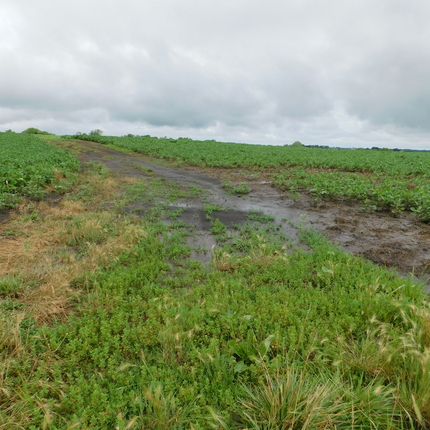By Cora Fox, former staff member
Living in the Loess Hills of Iowa most of my life, I’ve witnessed a variety of conservation concerns. With an increase in weather extremes, including heavy rain events, our highly erodible land is prone to increased erosion. This erosion often presents in the form of ephemeral gullies.
What is an ephemeral gully?
An ephemeral gully is a somewhat shallow, but wide, drainage ditch that naturally occurs in a field. An ephemeral gully is larger than a rill, and smaller than a gully. Ephemeral gullies often occur as a result of multiple rills coming together and forming a tree-like pattern of channels in the soil.
Many farmers till through ephemeral gullies during planting, but this damaging practice doesn’t effectively mitigate the problem. When topsoil is tilled over an ephemeral gully, the loose soil is given a path to run off during the next rain event.
Taking care of soil is an investment in the land. Farmers know this, which is why they spend time and money amending the soil in preparation for next year’s crop. However, ignoring the cause of ephemeral gullies and simply tilling through them counteracts the good work that farmers do to take care of their land. The nutrient-rich topsoil erodes and washes away into our waterways, which reduces land productivity and negatively impacts water quality.
Beyond the economic and environmental impact of ephemeral gullies, it is important to note that farmers are held responsible for controlling erosion on fields that are classified as highly erodible. To receive benefits from U.S. Department of Agriculture (USDA) programs, a farmer must be in compliance with conservation requirements.
To help assist farmers in addressing ephemeral gullies, USDA Natural Resources Conservation Services (NRCS) has developed a pilot project through the Environmental Quality Incentives Program (EQIP). This project provides financial assistance to support in implementing conservation practices, such as cover crops, no-till, buffer strips, terraces, and more. These practices work to prevent recurring ephemeral gullies in fields.
Farmers who have received variances as a result of conservation compliance reviews in the past two years are given priority in the application process, but the funding is available to any Iowa farmer with an ephemeral gully on their land. The deadline to apply is June 21, 2019. Contact your local NRCS office to learn more.



